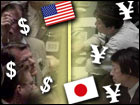
NEW YORK (CNN/Money) -
For years, the Japan question has come up only to be quickly swatted down. There's no way we'd let our economy languish for 12 years like the Japanese have, said the optimists. This is America, and when we've got a problem we fix it.
One of Japan's biggest problems has been deflation -- a decline in overall price levels -- and a June paper from the Federal Reserve titled, "Preventing Deflation: Lessons from Japan's Experience in the 1990's," has got the U.S.-is-Japan worries revving again.
"Everyone's talking about the Fed's deflation paper," said Credit Suisse First Boston bond market strategist Mike Cloherty. "You're starting to see a lot of people talk about Japan and comparing it to here."
The comparison isn't hard to draw. Japan had a bubble, the United States had a bubble. Japan's banks are unwilling to lend to businesses despite low interest rates, and U.S. banks are increasingly unwilling to lend despite low interest rates.
And now the Fed paper raises a worry that the same deflationary forces that have helped prevent a Japanese recovery could happen in the United States too. Deflation impedes economic growth by discouraging spending. For consumers, there's no sense in making a big-ticket purchase when you may be able to pay less at a later time. And when prices are falling, businesses earn progressively less on what they sell, making banks reluctant to lend to them.
It's a vicious cycle, and in Japan, it has contributed to a stock market 70 percent below where it was in December 1989 at the peak of its bubble.
The deflation scenario is gaining adherents. In a recent note PIMCO economist Paul McCulley called on Fed Chairman Greenspan to commit to raising the rate of inflation in order to prevent a deflationary episode. (Because PIMCO, with over $250 billion in assets, is the biggest bond fund manager, McCulley's point of view matters to the market -- regardless of whether he's right.)
Tuesday Princeton economist and The New York Times editorialist Paul Krugman weighed in. "[I]f there's one thing we've learned from Japan's experience," he wrote, "it is that when you face the risk of a deflationary trap -- still not the most likely scenario, but not as unlikely as it seemed a few months ago -- it makes no sense to 'save your ammunition,' holding interest rates in reserve." The Fed should move now, he concluded.
Still not buying it
With the Fed paper making the rounds, Morgan Stanley chief U.S. economist Richard Berner has been fielding calls from worried clients. He thinks their concerns are overdone. "The Fed paper has been overinterpreted," Berner said. "People are treating it as news, and it's not."
The paper has likely been in the works for a long time -- Berner suspects it was begun around a year and a half ago. It doesn't represent new concerns at the Fed; it's just another piece of research that the Fed churns out every month.
(Other exciting papers that came out in June include "Finding numerical results to large scale economic models using path-following algorithms: a vintage capital example" and "Does the labor share of income drive inflation?")
Northern Trust chief U.S. economist Paul Kasriel thinks that if anything it's inflation that investors should worry about. "The Fed is printing money and the dollar is declining," he said. "Commodity prices are moving up." All are hallmarks of inflation.
Still, ignoring the lesson of Japan is a bad idea, thinks Ron Napier, the head of Napier Investment Advisors. Salomon Brothers' chief Asian economist in the 1980s, Napier is reminded how many times he was pooh-poohed in the late 1990s for saying that the U.S. stock market was just as much of a bubble as Japan's was. Thinking that the aftermath couldn't be as bad is similarly wrongheaded.
"All the economists are saying it's a normal cycle, it's time for the U.S. to recover," said Napier. "They said that in Japan, too. We want to think we're in our own unique boat here, so we'll escape it."
Napier thinks the aftermath of bubbles, no matter where they occur, have long legs. He notes that deflation wasn't a problem at the outset for Japan either. It was just that the excesses bred by the Japan's late 1980s exuberance left banks unwilling to lend to companies, despite low interest rates. (Sound familiar?) Companies that had once been flush were forced to go begging. Consumers held the line for a while but as unemployment rose they stopped buying like before. Occasionally it would look like Japan was finally working its way out of the rut and policy makers would declare the battle won -- only to see the economy slide anew.
And what about the other big investment bubble of the last 100 years, the U.S. stock market in the 1920s? In the aftermath of that, too, the government struggled to revive the economy and couldn't. And just like in Japan, there was a period of falling prices.
For the twentieth century, at least, the answer to the question, "What happens when you let the air out of a bubble?" has been "It deflates."

|

